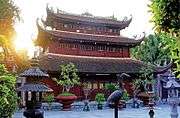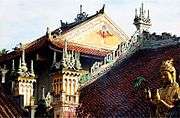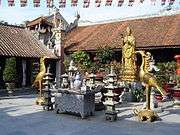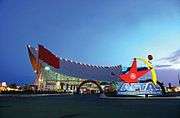Haiphong
| Hải Phòng City Thành phố Hải Phòng | |
|---|---|
| Municipality | |
 | |
| Nickname(s): Flamboyant City | |
 Provincial location in Vietnam | |
| Coordinates: 20°51′54.5″N 106°41′01.8″E / 20.865139°N 106.683833°E | |
| Country |
|
| Government | |
| • Party Secretary: | Lê Văn Thành |
| • People's Council Chairman: | Dương Anh Điền |
| • People's Committee Chairman: | Lê Văn Thành |
| Area | |
| • Total | 1,527.4 km2 (589.7 sq mi) |
| Population (2015)[1] | |
| • Total | 2.103.500 (3rd in Vietnam) |
| • Density | 1,274/km2 (3,300/sq mi) |
| Time zone | ICT (UTC+07:00) |
| • Summer (DST) | No DST (UTC+7) |
| Area codes | 225 |
| Climate | Cwa |
| Website | Official website |
Haiphong (Vietnamese: Hải Phòng, ![]() listen) is the third largest city of Vietnam with population of over two million people. The city's name means "coastal defense" and it is nicknamed the Flamboyant City because of the many flame trees planted throughout it. Haiphong is Northern Vietnam's most important seaport and has many industrial parks invested by multinational corporations. In Vietnam, only Hanoi and Ho Chi Minh City are larger than Haiphong.
listen) is the third largest city of Vietnam with population of over two million people. The city's name means "coastal defense" and it is nicknamed the Flamboyant City because of the many flame trees planted throughout it. Haiphong is Northern Vietnam's most important seaport and has many industrial parks invested by multinational corporations. In Vietnam, only Hanoi and Ho Chi Minh City are larger than Haiphong.
Economy
Haiphong is a major economic center of the North in particular and Vietnam in general both. Under French domination, Haiphong was level 1 city, equal to Saigon and Hanoi. The last years of the 19th century, the French had proposed to build Haiphong into the economic capital of Indochina.[2] Today, Haiphong is still one of the most important economic center of Vietnam. In 2009, Haiphong state budget revenue reached 34,000 billion Vnd . In 2011, budget revenues in the city reached 47 725 billion, increase 19% compared to 2010.[3] In 2015, total revenues of the city reached 56 288 billion . Government plans that to 2020, Haiphong's revenues will be over 80,000 billion and the domestic revenue reached 20.000 billion. In the ranking of the Provincial Competitiveness Index (PCI) 2013 of Vietnam, Haiphong city ranked at No. 15/63 provinces.[4] Haiphong has relationship of trading goods with more than 40 countries and territories around the world. Haiphong is striving to become one of the largest commercial centers of the country.[5]
Industry
Industry is a key sector in Haiphong including food processing, light industries and heavy industries. Major products include fish sauce, beer, cigarettes, textiles, paper, plastic pipes, cement, iron, pharmaceuticals, electric fans, motorbikes, steel pipes and ships and out-sourcing software implementation.[6] Most of these industries have been growing significantly between 2000 and 2007, with the exceptions of the cigarette and pharmaceutical industries. Shipbuilding, steel pipes, plastic pipes and textiles are among the industries with the most rapid growth.[6]
There are also growing industries supplying products used by existing industries in the city. PetroVietnam set up a joint-venture PVTex with textile manufacturer Vinatex to build Vietnam's first polyester fiber plant in Haiphong. The factory will use by-products from oil-refining and reduce reliance on imported materials.[7] 270,600 people were employed in Haiphong's industry. 112,600 industrial jobs were created between 2000 and 2007.[6]
Agriculture, forestry and fishery
Despite its status as a city, around one third of Haiphong's area or 52,300 ha (as of 2007) are used for agriculture. Rice is the most important crop, taking up around 80% of the agricultural land with an output of 463,100 tons in 2007.[6] Other agricultural products include maize, sugar and peanuts.[6]
Haiphong has a relatively large fishing sector with an output of 79,705 tons (2007). Gross output has almost doubled between 2000 and 2007, mostly due to fast growth in aquaculture, which made up 60% of gross output in 2007. Despite its coastal location, sea fish contribute relatively little to the sector (around one fourth). Nam Định Province and Thái Bình Province have much larger fishing sectors and even the inland Hải Dương Province has a larger gross output from fishing than Haiphong.[6]
As of 2007, 315,500 were employed in agriculture and fishery, a significant decrease from 396,300 in 2000. However, these sectors still account for almost a third of total employment in Haiphong, a larger share than industry.[6] However, gross output in both agriculture and fishery have been growing significantly between 2000 and 2007.
Infrastructure
Transport
Sea links
Haiphong port is one of the largest ports in Vietnam and south-east Asia as a whole. The Port of Haiphong on the Cấm River is divided into three main docks: Hoang Dieu (Central terminal) located near the city's center, Chua Ve, and Dinh Vu both farther downstream to the east.[8] Several ferry terminals connect Haiphong with the neighboring Cát Hải and Cát Bà Islands; Ben Binh Ferry terminal is located near the city center while Dinh Vu Ferry is located on a spit of land on the coast. The government had approved the plans to build an international port in Lach Huyen – 15 kilometers from the current port. Once completed this will be one of the deepest port in Vietnam with draft of 14m, capable of receiving ships up to 100.000 DWT.
Land routes
Haiphong is located at the junction of two National Highways: Route 5, leading west to Hanoi, and Route 10, leading south to Nam Định and onward to connect with National Route 1A at Ninh Bình. Highway 356 passes west–east from the Route 5/10 junction through Haiphong's city center all the way to the coast. A connecting road from route 5 to route 18 links Haiphong with Quảng Ninh Province. In 2015, the new highway connecting Haiphong with Hanoi was completed; this is the most modern highway in Vietnam and reduces the trip by one hour as compared to the previous route.[9]
Within the city there are several long-distance bus depots: Niem Nghia, Cau Rao.
Air travel
The main airport serving Haiphong is Cat Bi International Airport with three flights daily to Ho Chi Minh city. In April, 2011 Vietnam Airlines launched routes to Da Nang with 5 flights a week. An international airport for Haiphong, situated in Tien Lang district, is in the planning stages; if realized it would become the largest airport in northern Vietnam.
Rail links
Hai Phong Railway Station built in 1902 is the eastern terminus of the Kunming–Hai Phong Railway, also known as the Yunnan–Vietnam Railway. Built at by the French during their occupation, the railway once connected Haiphong to the city of Kunming in Yunnan, China, although service along the Chinese portion of the line is currently suspended. Rail travel from Haiphong with connections to the rest of the Vietnamese railway network is via Hanoi.
Education
- Hai Phong Medical University
- Haiphong University
- Vietnam Maritime University
- Haiphong private University
History
To the Mac Dynasty
Haiphong is the home of Lê Chân, one of the female generals under the command of the Trưng Sisters who rose against Chinese rule in 40 AD and ruled until their defeat in 43 AD. Centuries later under the Mạc Dynasty the area earned the appellation Hải tần Phòng thủ ("defensive coastal area") as it protected the eastern flank of Mac kings' home province.
Nguyen Dynasty
By the 19th century at the end of Nguyễn Emperor Tự Đức's reign, the Hang Kenh Communal House in what is now the city's Le Chan district was made the administrative seat of An Dương District, restoring its regional importance.[10] The area by then had developed into a sizable commercial port.
At the eve of the French conquest in 1881, a devastating typhoon ravaged the area, claiming up to 300,000 lives. Despite the damages, Haiphong was developed by the French to serve as Indochina's main naval base over the ensuing decades.
Democratic Republic of Vietnam & the Vietnam War
Following the defeat of Japan in World War II, Vietnamese nationalists agitated for independence against the French return. French forces landed in Haiphong and encountered resistance which killed three French troops. In retaliation the French ships, among them the cruiser Suffren, shelled the city, setting it ablaze[11] and precipitating the First Indochina War.[12][13] French infantry forces under the command of Jean-Étienne Valluy entered the city, fighting house to house with the support of armored units and airplanes.[14]
Late in the Vietnam War, Haiphong was subjected to heavy bombing by US Navy and Air Force strike aircraft because it was North Vietnam's only major port. U.S. Admiral Thomas H. Moorer ordered the mining of Haiphong harbor on 8 May 1972, effectively sealing the port. Until it was lifted, the mining caused no casualty.[15][16] Despite being targeted, the physical structure of the city was mostly unaffected by the war as the US had a self-imposed prohibition zone for the city. After the war, the city recovered its role as a significant industrial center.[10]
Demographics
Haiphong is the third most populous city in Vietnam, with a population of 2.103.500 for the metropolitan area (2015), encompassing an area of 1,507.57 km², 46,1 % of population reside in the urban districts.[17] The gender distribution is half female (50.4%).[18]
- Population growth
As of the 2009 census, Haiphong's average annual population growth rate was given as 4.0%. Haiphong's crude birth rate was recorded at 18.1 live births per 1000 persons vs the crude death rate of 7.6 per 1000 persons. Life expectancy at birth was estimated at 77.1 years for women and 72.0 years for men, or 74.5 years overall. Infant mortality rate was measured at 11.8 infant deaths per 1000 live births, just over two points above the nation's average for urban areas. In the same census, the city's out-migration was 1.9% vs in-migration of 2.8% and, for a net migration rate of 0.9%.[18]
Geography
Haiphong is a coastal city located at the mouth of the Cấm River (Forbidden River), in Vietnam's north-eastern coastal area, 120 km east of Hanoi. The Bính Bridge crosses the Cam and connects the city with Thủy Nguyên District. It has a total natural area of 152,318.49ha (2001). It borders Quảng Ninh Province to the north, Hải Dương Province to the west, Thái Bình Province to the south, and the Gulf of Tonkin to the east. Bach Long Vi island, Cat Ba Island and the Long Châu islands, located in the Gulf, are also administered as part of the city.
The city is located in a convenient position for transportation to domestic provinces, and international networks via road network, railway, sea routes, inland waterway and air.

Climate
Haiphong features a humid subtropical climate, with hot, humid summers and warm, dry winters. The city is noticeably wetter from April through October; roughly 90% of the city's annual precipitation (which is approximately 1600 mm of rainfall) typically falls during these months. There is a noticeable difference in temperatures between the city's winters and summers. Haiphong's coolest months, January and February, sees average high temperatures reach 20 degrees Celsius and average low temperatures at around 14 degrees Celsius. Its warmest months, June and July, sees average high temperatures hover around 33 degrees Celsius and average low temperatures at around 26 degrees Celsius. Sea temperatures range from a low of 21 °C (70 °F) in February to a high of 30 °C (86 °F) during the months of July and August.[19]
| Climate data for Haiphong (1971–2000) | |||||||||||||
|---|---|---|---|---|---|---|---|---|---|---|---|---|---|
| Month | Jan | Feb | Mar | Apr | May | Jun | Jul | Aug | Sep | Oct | Nov | Dec | Year |
| Record high °C (°F) | 30.4 (86.7) |
31.3 (88.3) |
35.0 (95) |
37.4 (99.3) |
39.4 (102.9) |
38.4 (101.1) |
38.4 (101.1) |
38.9 (102) |
38.3 (100.9) |
33.7 (92.7) |
33.1 (91.6) |
32.9 (91.2) |
39.4 (102.9) |
| Average high °C (°F) | 19.7 (67.5) |
19.8 (67.6) |
22.1 (71.8) |
26.2 (79.2) |
30.5 (86.9) |
32.0 (89.6) |
32.1 (89.8) |
31.5 (88.7) |
30.8 (87.4) |
28.6 (83.5) |
25.5 (77.9) |
22.2 (72) |
26.8 (80.2) |
| Daily mean °C (°F) | 16.2 (61.2) |
16.8 (62.2) |
19.2 (66.6) |
22.9 (73.2) |
26.4 (79.5) |
28.2 (82.8) |
28.4 (83.1) |
27.7 (81.9) |
26.8 (80.2) |
24.4 (75.9) |
21.2 (70.2) |
17.9 (64.2) |
23.1 (73.6) |
| Average low °C (°F) | 14.2 (57.6) |
15.1 (59.2) |
17.6 (63.7) |
21.0 (69.8) |
24.0 (75.2) |
25.7 (78.3) |
25.9 (78.6) |
25.3 (77.5) |
24.2 (75.6) |
21.8 (71.2) |
18.6 (65.5) |
15.3 (59.5) |
20.8 (69.4) |
| Record low °C (°F) | 6.0 (42.8) |
5.2 (41.4) |
6.1 (43) |
12.0 (53.6) |
16.8 (62.2) |
20.9 (69.6) |
20.3 (68.5) |
21.6 (70.9) |
15.6 (60.1) |
13.5 (56.3) |
9.3 (48.7) |
4.9 (40.8) |
4.9 (40.8) |
| Average rainfall mm (inches) | 37.1 (1.461) |
38.2 (1.504) |
79.6 (3.134) |
111.0 (4.37) |
241.0 (9.488) |
298.3 (11.744) |
312.4 (12.299) |
473.0 (18.622) |
324.4 (12.772) |
194.6 (7.661) |
53.4 (2.102) |
46.0 (1.811) |
2,209 (86.968) |
| Average rainy days (≥ 1.0 mm) | 5.00 | 7.97 | 10.24 | 8.68 | 9.63 | 11.59 | 11.33 | 15.30 | 10.60 | 8.07 | 3.33 | 2.63 | 104.37 |
| Average relative humidity (%) | 78 | 86 | 90 | 91 | 87 | 86 | 86 | 88 | 87 | 80 | 83 | 79 | 85.1 |
| Mean monthly sunshine hours | 88.6 | 41.1 | 41.9 | 88.7 | 197.9 | 185.3 | 217.3 | 177.2 | 188.4 | 184.3 | 161.3 | 140.8 | 1,712.8 |
| Percent possible sunshine | 26.3 | 12.9 | 11.4 | 23.7 | 49.1 | 46.7 | 53.4 | 45.1 | 52.0 | 51.8 | 48.9 | 42.2 | 39.1 |
| Source #1: south-east Asian Climate Assessment & Dataset (extremes 1958–2000, sun 1961–1990)[20][21][22][23][24][25][26][27][lower-alpha 1] | |||||||||||||
| Source #2: Weatherbase (humidity)[28] | |||||||||||||
| Month | Jan | Feb | Mar | Apr | May | Jun | Jul | Aug | Sep | Oct | Nov | Dec | Year |
|---|---|---|---|---|---|---|---|---|---|---|---|---|---|
| Average temperature °C (°F) | 22 °C (72 °F) | 21 °C (70 °F) | 22 °C (72 °F) | 24 °C (75 °F) | 27 °C (81 °F) | 29 °C (84 °F) | 30 °C (86 °F) | 30 °C (86 °F) | 29 °C (84 °F) | 28 °C (82 °F) | 26 °C (79 °F) | 23 °C (73 °F) | 26 °C (79 °F) |
Administrative divisions
Haiphong is subdivided into 15 district-level sub-divisions:
- 8 rural districts:
- 7 urban districts:
They are further subdivided into 10 commune-level towns (or townlets), 148 communes, and 72 wards.
Table of local government districts
| District | Number of wards (communes and towns) |
Area (km²) (2009) |
Population (Census April 1, 2009) |
Density (people/km²) |
|---|---|---|---|---|
| Dương Kinh | 6 wards | 45.85 | 48,700 | 1,062.16 |
| Đồ Sơn | 7 wards | 42.37 | 44,514 | 1,050.6 |
| Hải An | 8 wards | 88.39 | 103,267 | 1,168.31 |
| Kiến An | 10 wards | 29.6 | 97,403 | 3,290.64 |
| Hồng Bàng | 11 wards | 14.27 | 101,625 | 7,121.58 |
| Ngô Quyền | 13 wards | 10.97 | 164,612 | 15,005.65 |
| Lê Chân | 15 wards | 12.31 | 209,618 | 17,028.27 |
| Sub-Total (Urban Districts) | 70 wards | 243.76 | 769,739 | 3,157.77 |
| An Dương | 1 town + 15 communes | 98.29 | 160,751 | 1,635.47 |
| An Lão | 2 towns + 15 communes | 113.99 | 132,316 | 1,160.77 |
| Bạch Long Vĩ | - | 4.5 | 902 | 200.4 |
| Cát Hải | 2 towns + 10 communes | 323.1 | 29,676 | 91.84 |
| Kiến Thụy | 1 town + 17 communes | 107.5 | 126,324 | 1,175.1 |
| Tiên Lãng | 1 town + 22 communes | 191.2 | 141,288 | 738.95 |
| Vĩnh Bảo | 1 town + 29 communes | 180.5 | 173,083 | 958.91 |
| Thủy Nguyên | 2 towns + 35 communes | 242.8 | 303,094 | 1,248..32 |
| Sub-Total (Rural Districts) | 10 towns + 148 communes | 1,261.98 | 1,067,434 | 845.84 |
| Total | 70 wards, 10 towns, 148 communes | 1,505.74 | 1,837,173 | 1,220.11 |
Notable people
- Mạc Đăng Dung (1483–1541) king of Đại Việt country, the founder of the Mạc dynasty
- Nguyễn Bỉnh Khiêm (1491–1585) thinker, poet, prophet, Cao Dai religion saint
- Mai Trung Thu (1906–80) painter
- Văn Cao (1923–95) musician, poet, painter and composer of the national anthem of Vietnam Tiến Quân Ca
- Ngọc Sơn (1970– ) singer, songwriter
- Trà Giang (1942– ) film actress (born in Quảng Ngãi Province, grew up and schooled in Haiphong)
- Phan Thị Hà Thanh (1991– ) artistic gymnast, first gymnast to win a world medal for Vietnam gymnastics (2011)
- Thu Phương (1972-) famous pop singer and Haiphong native; she now lives in the U.S.
Twin towns and sister cities
-
 Da Nang, Vietnam
Da Nang, Vietnam -
 Incheon, South Korea
Incheon, South Korea -
 Seattle, USA
Seattle, USA -
 Tianjin, China
Tianjin, China -
 Saint Petersburg, Russia
Saint Petersburg, Russia -
 Vladivostok, Russia
Vladivostok, Russia -
 Kitakyushu, Japan
Kitakyushu, Japan
Gallery
|
See also
References
- ↑ Statistical Handbook of Vietnam 2015, General Statistics Office Of Vietnam
- ↑ http://hoaphuongdo.vn/news/tin-tuc-su-kien/kinh-te-doanh-nghiep/46701-lien-ket-phat-trien-giua-ha-noi-va-hai-phong-dong-vai-tro-quan-trong.html
- ↑ http://www.hoaphuongdo.vn/news/xa-hoi-cong-dong-gioi-tre-nhip-song/66811.html?task=view
- ↑ http://www.pcivietnam.org/rankings_general.php
- ↑ http://haiphong.gov.vn/Portal/Detail.aspx?Organization=SNV&MenuID=5550&ContentID=15545
- 1 2 3 4 5 6 7 General Statistics Office (2009): Socio-economic Statistical Data of 63 Provinces and Cities, Vietnam. Statistical Publishing House, Hanoi
- ↑ "PVTex to operate first polyester fiber project early 2011". The Saigon Times. 2010-05-14. Retrieved 2011-07-06.
- ↑ Haiphong Port: Maps
- ↑ http://www.vidifi.vn/english/index.php?option=com_content&view=article&id=4:hanoi-%E2%80%93-hai-phong-expressway-project&catid=3&Itemid=65
- 1 2 Haiphong's Culture. HaiphongTourism.gov.vn
- ↑ Vietnam by Spencer C. Tucker, page 47. "On 23 November DebeS delivered an ultimatum to the Vietnamese at Haiphong, ordering them to withdraw from the French section of the city, the Chinese quarter, and the port. He gave them only two hours to reply. When the time was up the French subjected the Vietnamese positions to air, land, and sea bombardment, the bulk of the firepower coming from the three- and eight-inch guns of the French Navy Cruiser Suffren. Only military targets were destroyed and not the Vietnamese quarter as some have claimed. Estimates of the number killed in the shelling and ensuing panic vary widely. Casualties up to 20,000 have been cited. French Admiral Batter later said that no more than 6,000 Vietnamese had died, but in 1981 Vu Quoc Uy, then chairman of the Haiphong municipal committee, told Stanley Karnow that the figure was only 500 to 1,000 dead. Others have put the figure as low as 200".
- ↑ (French) Maurice Vaïsse, L'Armée française dans la guerre d'Indochine (1946–1954) : Adaptation ou inadaptation, 2000, p. 276
- ↑ Plon, Le General de Gaulle et l'Indochine 1940–1946, page 210. "In connection with the naval bombardment, let us note that only the ships of small tonnage could go up the river of Haiphong. On November 23, two colonial sloops supported for the first time the French troops with their artillery to a limited effect: the Chevreuil with its double turret, with its two pairs of 100mm, Savorgnan de Brazza with its four turrets each of one 138mm. No battleship was present. On November 27 on that the evening, the cruiser Suffren was in the Bay d' Along, its tidal water prohibiting it access of the Cua Cam. It transported troops in reinforcement..."
- ↑ Phillippe Devillers, Histoire du Viêt-Nam de 1940 à 1952. Editions du Seuil, Paris. Third edition,1952, pp. 331–340
- ↑ Interview with Thomas H. Moorer, 1981 "We took about twenty-six aircraft off of one aircraft carrier, and they were airborne about an hour and a half, and we mined Hai Phong Harbor, and not one ship entered or left ah, that Harbor until we, ourselves, removed the mines. No one person was hurt, or in any way...", http://openvault.wgbh.org/catalog/vietnam-59ce8c-interview-with-thomas-h-moorer-1981
- ↑ Forbes, Andrew, and Henley, David: Vietnam Past and Present: The North (History and culture of Hanoi and Tonkin). Chiang Mai. Cognoscenti Books, 2012. ASIN: B006DCCM9Q.
- ↑ Bureau of East Asian and Pacific Affairs (May 27, 2010). "Background Note: Vietnam". U.S. Department of State. Retrieved 2010-06-21.
- 1 2 The 2009 Vietnam Population and Housing census: Major findings. General Statistics Office of Vietnam.
- 1 2 Haiphong Climate Guide, Retrieved 9 August 2012.
- ↑ "Climatology Maps: Mean of daily maximum temperature". Badan Meteorologi Klimatologi dan Geofisika (BMKG). Retrieved October 15, 2015.
- ↑ "Climatology Maps: Mean of daily mean temperature". Badan Meteorologi Klimatologi dan Geofisika (BMKG). Retrieved October 15, 2015.
- ↑ "Climatology Maps: Mean of daily minimum temperature". Badan Meteorologi Klimatologi dan Geofisika (BMKG). Retrieved October 15, 2015.
- ↑ "Climatology Maps: Precipitation Sum". Badan Meteorologi Klimatologi dan Geofisika (BMKG). Retrieved October 15, 2015.
- ↑ "Climatology Maps: Wet Days (RR>=1.0 mm)". Badan Meteorologi Klimatologi dan Geofisika (BMKG). Retrieved October 15, 2015.
- ↑ "Climatology Maps: SS: Sunshine Duration". Badan Meteorologi Klimatologi dan Geofisika (BMKG). Retrieved October 15, 2015.
- ↑ "Climatology Maps: Sunshine duration fraction with respect to daylength (1961–1990 period)". Badan Meteorologi Klimatologi dan Geofisika (BMKG). Retrieved October 15, 2015.
- ↑ "Indices data: Minimum of daily minimum temperature and Maximum of daily maximum temperature". Badan Meteorologi Klimatologi dan Geofisika (BMKG). Retrieved October 15, 2015.
- ↑ Weatherbase: Historical Weather for Haiphong, Weatherbase. Retrieved 11 August 2012.
Notes
- ↑ Station ID for Phu Lien (Haiphong) is 304. Download the data, open the text files for each month and use this station ID to obtain monthly values for this location
External links
| Wikivoyage has a travel guide for Haiphong. |
| Wikimedia Commons has media related to Haiphong. |
- Official Website of Haiphong City
- Official Website of Haiphong Tourism.
- History of Haiphong: interactive Google Map with specific sites and historic views of the city from French colonial times.
 |
Hải Dương Province | Quảng Ninh Province |  | |
| |
Gulf of Tonkin Guangdong, | |||
| ||||
| | ||||
| Thái Bình Province | Gulf of Tonkin | Gulf of Tonkin Hainan, |
Template:Vietnam
Coordinates: 20°51′54.5″N 106°41′01.8″E / 20.865139°N 106.683833°E




.jpg)

